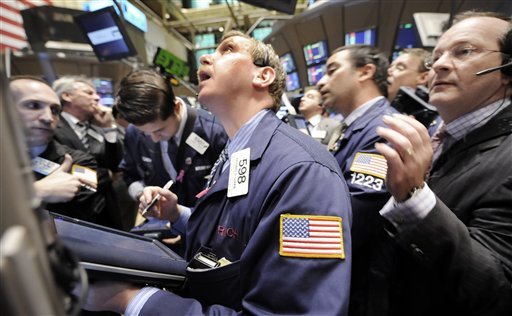Wall Street remained tense Thursday, swinging between sharp
gains and losses as investors examined mixed economic and earnings
data for clues about the health of the economy.
TIM PARADIS – Associated Press
NEW YORK
Wall Street remained tense Thursday, swinging between sharp gains and losses as investors examined mixed economic and earnings data for clues about the health of the economy. The Dow Jones industrials, down 380 at one point, closed more than 400 points up; the major indexes were also saw broad gains.
A rise in shares of Yahoo Inc. over renewed speculation it could cement a deal with one-time suitor Microsoft Corp. helped push the technology-heavy Nasdaq composite index up more than 3 percent.
Stocks spent much of the session seeking a direction after the previous session’s steep dive, and for a time turned lower after a disappointing report Thursday morning on manufacturing. Wednesday’s drop, which took the Dow down 733 points, followed a stream of bad economic news that underscored the likelihood that the country is either in a recession or will be in one – and that the downturn could be severe.
It was clear from Thursday’s trading that the market will continue having extreme reactions to any economic news.
“I don’t think the markets have a clear sense about the economic environment as of yet. They’re clearly nervous,” said Subodh Kumar, global investment strategist at Toronto-based Subodh Kumar & Associates.
Broader stock indicators also turned higher. The Standard & Poor’s 500 index rose 23.23, or 2.56 percent, to 931.07, and the Nasdaq composite index rose 60.74, or 3.73 percent, to 1,689.07.
Investors initially appeared cheered by a better-than-expected reading from the Labor Department on consumer prices. The flat reading on September’s Consumer Price Index compares with August’s 0.1 percent decline, which was the first in nearly two years. The core index, which eliminates food and energy prices, rose 0.1 percent. Economists had been expecting CPI would rise to 0.1 percent and that core CPI would increase 0.2 percent. Investors are relieved to see any economic pressures ease on consumers.
Meanwhile, a weekly snapshot of the job market showed that first-time claims for unemployment benefits declined last week. The Labor Department said new claims fell 16,000 last week to a seasonally adjusted level of 461,000 – below the 475,000 that had been anticipated. Still, total unemployment remains above the level that economists often associate with recession.
But the Philadelphia Federal Reserve said regional manufacturing conditions weakened in October. The bank’s regional index came in at a negative 37.5 compared with a positive 3.8 for September.
Kumar said markets are jittery because many investors’ expectations about the economy were too rosy heading into the summer and the monthlong freeze in the credit markets has dealt the economy another blow, making it harder and more expensive for many businesses and consumers to get loans.
He said the volatility buffeting the markets reflects investors tinkering with their portfolios to match their more sober take on the health of the economy and some investors simply cashing out. That means some vehicles like mutual funds and hedge funds are entering a market already short on buyers and being forced to sell.
Because of investors’ great anxiety about the economy, Wall Street is expected to remain extremely volatile, as it has been since last month when the credit markets tightened and stocks plunged. The gyrations this week have been particularly intense, with the Dow industrials soaring 936 points Monday and falling 733 Wednesday following a weak report on retail sales and a disheartening assessment of the economy from the Federal Reserve.













